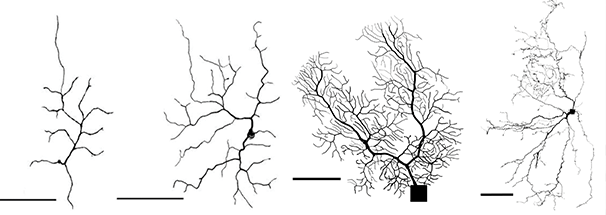Mapping the brain’s traffic
Engineers Ge Yang and Jessica Zhang are using complex geometric analysis to learn about neuron function and unlock the mysteries of the human brain.
The human brain dictates what we see, what we feel, what we think. Our brains are integral to every aspect of our lives, but there is still so much we do not know about them. They remain a mystery, a complicated web of neurons that works in ways scientists and engineers can only begin to explain. How do neurons interact? How do they communicate with each other? How do they function properly?

Source: Ge Yang, Jessica Zhang, Angran Li
The simulation result in a mouse cerebellum Purkinje neuron showing the dynamic material transport process for 340 seconds.
These are just some of the questions Ge Yang, associate professor of biomedical engineering and computational biology, and Jessica Zhang, professor of mechanical engineering, are trying to answer in their research. Using novel engineering models, methods, and software, Yang and Zhang are studying how essential materials, such as chemical signals and cell parts made in the nucleus, are transported within the complex geometry of neurons and creating simulations that represent this transport system. In June 2018, they were awarded a National Science Foundation (NSF) grant to continue their research for three years.
Neurons come in many shapes and sizes, but each has the same foundational structure. The axon is a thin, long wire-like structure that transports information, signals, and materials from the cell body to communicate with other neurons. Like how an urban center both distributes materials throughout metropolitan areas and collects garbage and recycling from these areas, a neuron sends out and collects materials and signals. This transport system is critical for brain function and ultimately human survival—and it’s at the center of Yang and Zhang’s research.
“This process is literally a matter of life and death for a neuron,” said Yang. “If this process shuts down, then the neurons will die. For example, with Alzheimer’s disease, the brain is smaller size-wise, but it also has many holes. These holes are made due to massive death of neurons. There are all kinds of theories about Alzheimer’s, and one of the theories which has received fairly strong experimental data support is that there’s a traffic problem.”
We're really pushing the limits of the technology right now.
Ge Yang, Associate Professor, Biomedical Engineering & Computational Biology, Carnegie Mellon University
To better understand how the unique and complex geometry of different neurons affect how cargo is transported and distributed, Yang and Zhang are developing computer simulations of how materials are transported in the neuron geometry.
“We're using a very advanced method called isogeometric analysis,” said Zhang. “The neurite tree of a neuron is very complex—we use more than 1,000 processors for the simulations.”
Isogeometric analysis (IGA) is a recently-developed computational method that allows numerous models to be designed and tested from a data set all at once. Using IGA, Yang and Zhang simulate the flow of materials inside the geometry of a neuron. The warmer the color, the higher the density of flow. As the materials flow from branch to branch away from the cell body, the color cools. At branch junctions, where there is more traffic, there is higher flow and thus a warmer color.
“Jessica’s lab is using the supercomputer in the Pittsburgh Supercomputing Center because the calculations are very complex,” said Yang. “When we do this, it involves millions of units in the calculations. We're really pushing the limits of the technology right now. If the computer simulation is done properly, it is going to have a very large impact on people’s understanding of the neuron’s geometry.”

Source: Ge Yang, Jessica Zhang, Angran Li
Examples of complex neuron geometry
In 2016, Yang and Zhang received seed support from the Department of Mechanical Engineering, which allowed them to take on a Ph.D. student, Angran Li, who has worked on developing software and simulations for this project.
Overall, Yang and Zhang have two main goals. First, they want to better understand the transport process of neurons, which can provide new insight on the development of neurodegenerative diseases. Second, when it comes to neurodegenerative disease, they hope to learn more about how drug delivery can be effectively distributed in the complex structure of neurons.
“It’s a fundamental scientific and engineering question,” said Yang. “The long-term goal is to develop a whole theory on how material is transported. This complex structure, with the physiology of neurons—it has a fundamental impact on life.”
Learn more about Jessica Zhang’s research:
